| Article ID | Journal | Published Year | Pages | File Type |
|---|---|---|---|---|
| 10957004 | Molecular and Cellular Neuroscience | 2005 | 12 Pages |
Abstract
From a repertoire of â¼2000 odorant receptor (OR) alleles in the mouse genome, a mature olfactory sensory neuron (OSN) is thought to choose only one functional allele of one OR gene for expression. OSNs that express a given OR gene are scattered throughout an epithelial region that is gene specific. The DNA sequences that enable OR gene choice and specify the epithelial pattern are not known. Within the upstream regions of several mouse, rat, and human OR genes, we have previously recognized putative homeodomain and O/E-like binding sites in proximity to each other. Here, we define a minimal promoter region for expression of the mouse OR gene M71 with small transgenes. This region contains a homeodomain and an O/E-like binding site. Combined mutations in both sites abolish transgene expression. When identical mutations are introduced at the endogenous M71 locus by gene targeting, the number of M71-expressing OSNs is reduced by a factor of three and the epithelial pattern is ventralized. The stronger impact observed with the mutant transgenes compared to the targeted mutations may reflect a multiplicity of regulatory sites within the OR gene cluster. We propose that these homeodomain and O/E sites regulate the probability of M71 gene choice differentially across the olfactory epithelium.
Related Topics
Life Sciences
Biochemistry, Genetics and Molecular Biology
Cell Biology
Authors
Andrea Rothman, Paul Feinstein, Junji Hirota, Peter Mombaerts,
